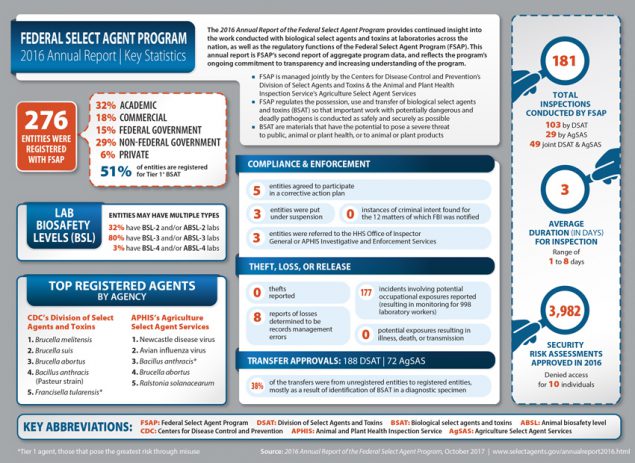2016 Annual Report of the Federal Select Agent Program
The 2016 Annual Report of the Federal Select Agent Program pdf icon[PDF – 890 KB], released in October 2017, summarizes 2016 data for the Federal Select Agent Program (FSAP), which regulates the possession, use and transfer of biological select agents and toxins so that important work with potentially dangerous and deadly pathogens is conducted as safely and securely as possible. FSAP is a partnership between HHS’s Centers for Disease Control and Prevention and USDA’s Animal and Plant Health Inspection Service.
The 2016 annual report is FSAP’s second report of aggregate program data, and reflects the program’s ongoing commitment to increasing transparency and understanding of the program. While similar in content to the information contained in last year’s report, the data provide continued insight into the work conducted with select agents and toxins at laboratories across the nation, as well as how the program provides regulation and oversight of these laboratories.
Key Findings
- As of December 31, 2016, 276 entities were registered with FSAP to possess a select agent or toxin. Most were from academic (32 percent) or non-federal government (29 percent) institutes, with the remaining from commercial (18 percent), federal government (15 percent), or private entities (6 percent).
- 181 inspections of registered entities were conducted by FSAP. The average length of an inspection was 3 days, with a range of 1 to 8 days.
- Laboratories that work with select agents and toxins range from biosafety level 2 (BSL-2) to maximum containment at biosafety level 4 (BSL-4). At each containment level, there is an equivalent set of biosafety guidelines for work with animals, designated as animal biosafety level (ABSL). Entities may be registered for multiple biosafety level laboratories. In 2016:
- 32% had BSL-2 and/or ABSL-2 laboratories
- 80% had BSL-3 and/or ABSL-3 laboratories
- 3% had BSL-4 and/or ABSL-4 laboratories
- After undergoing a security risk assessment, 3,982 individuals were approved in 2016 to have access to select agents or toxins; access was denied to 10 individuals based on results from a security risk assessment.
- FSAP was notified of 177 separate incidents resulting in potential occupational exposure to workers. As a result of these incidents, 998 laboratory workers were monitored for illness. None of these workers developed illness or transmitted a pathogen to others, either inside or outside of the laboratory.
- Eight reports of select agent or toxin inventory losses were investigated by FBI. All were determined to be the result of records management errors. No thefts of select agents or toxins were reported.
- The vast majority of laboratories are doing well in following the select agent regulations. When particularly serious deficiencies in biosafety or security measures are identified, FSAP can take additional actions to address an identified risk and bring the entity back into compliance with the select agent regulations. In 2016:
- Five entities agreed to participate in the corrective action plan (CAP) program
- Three entities were placed under suspension
- Three entities were referred to the HHS Office of Inspector General or APHIS Investigative and Enforcement Services for possible civil penalties.
- No instances of criminal intent were found for the 12 matters of which FBI was notified.
- In 2016, FSAP approved 260 transfers of select agents or toxins. Thirty-eight percent of those transfers involved unregistered entities transferring to registered entities, mostly as a result of the identification of a select agent in a diagnostic specimen.

